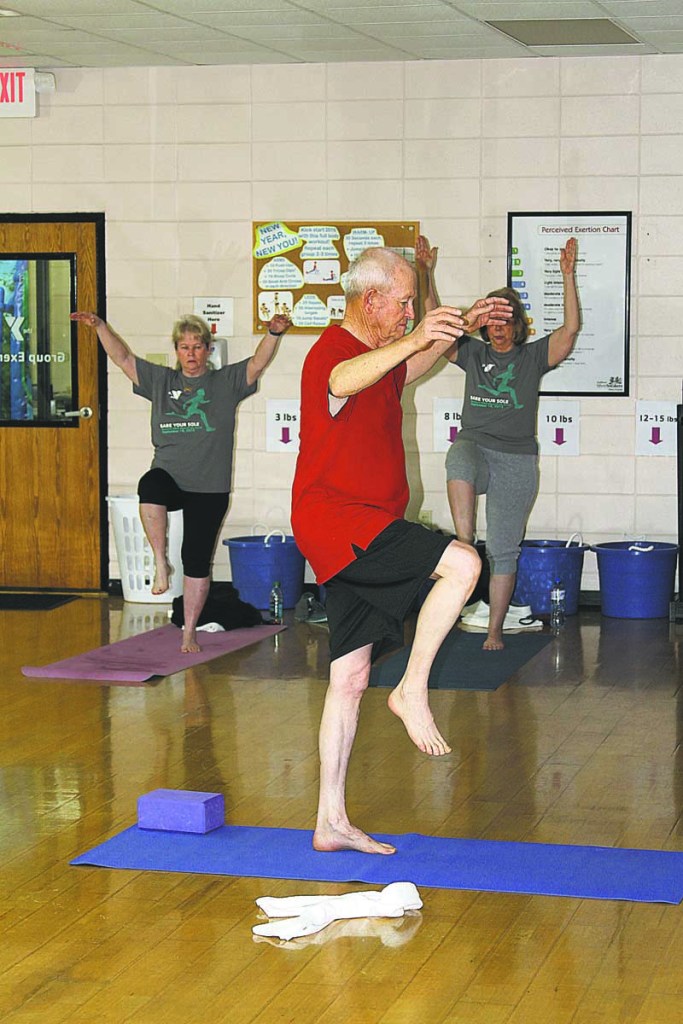70-year-old Georgia farmer, yoga student becomes the instructor
Published 1:45 pm Monday, June 27, 2016

- Stan Savage balances on one foot during a yoga class he teaches at the Moultrie, Georgia YMCA. Savage said afterwards he’d never been able to stand on one foot, even as a child, until he started taking yoga about three years ago.
MOULTRIE, Ga. — As the saying goes, you can’t teach an old dog new tricks. But can you teach an old farmer new poses? In the case of a septuagenarian in south Georgia, it turns out that you can — and he will, in turn, teach them to others.
“I couldn’t stand on one foot. Even as a kid I couldn’t do it,” Stan Savage of Moultrie, Georgia, said.
Twenty minutes earlier, the 70-year-old farmer-turned-yogi was perched on his right foot like a stork with his left foot resting against his right thigh. He looked as stable as a mailbox post standing in concrete.
What enabled him to perform this feat of balance? Yoga, courtesy of his local YMCA.
“These are the anchor points,” he explained afterwards. He touched a spot behind his big toe — what many call the “ball” of the foot — then a spot behind his little toe, the outer part of his heel and the inner part of his heel. “You don’t think of it as standing on one foot. You think about being anchored through those four points.”
Yoga has long been associated with Eastern spiritualism, but Savage came to it through the decidedly un-mystical practice of weightlifting. He’d been lifting weights for years and found his muscles very stiff after the workouts. An acquaintance had been taking yoga at the Y for a while, and recommended Savage try it to work the stiffness out.
“I started coming to yoga (three years ago) and I haven’t missed since,” Savage said.
Yoga is an extremely low-impact workout. It focuses on stretches and breathing techniques, Savage said, and it’s shown to improve balance, flexibility and strength. In the last decade, the practice of yoga has become a multi-million dollar growth industry — spawning merchandise and class options in cities and communities across the country.
Savage became a yoga instructor sort of by default. As he learned from his instructor, he also studied books about the practice. He became proficient to the point he’d fill in when his instructor was out. He stepped in full-time in August 2014.
YMCA Senior Programs Director Robin McCord said the staff has encouraged Savage to become a certified instructor so he could be paid for teaching the class. Savage, a retired county extension agent who runs a cattle farm, shook his head with a smile. “I don’t need that,” he told the Moultrie, Georgia Observer.
Savage said he spends one to two hours planning and preparing for each 45-minute class, which is held at 9:30 a.m. Mondays, Wednesdays and Fridays. He plans what exercises to do and studies the reference works he owns.
The class starts with stretches that limber up the torso, then the neck, shoulders, spine, hips and knees.
“We try to get as much motion out of the joints we can without bending the back,” Savage explained.
The exercise is not competitive, he insisted. The only competition you have is with yourself. Some people are more flexible or have been training longer, so they can do things a novice can’t yet — and no one should judge themselves by what someone else in the class is doing.
“You go to your level of comfort and you push to your satisfaction,” he said.
The oldest person in the class is 77, and Savage has taught participants as young as their teens. With that variability in age the absence of competition can be a big draw for the class. Savage started with 3-7 people in his class, but it now runs 18-24.
Yoga exercises — often called “positions” or “poses” — mainly consist of putting your body into a certain position that tends to stretch muscles or require balance and hold that position for a certain number of breaths. Many positions have names that refer to animals or natural objects.
For instance, in the Downward Facing Dog position, the participant is balanced on his feet and hands with his hips up in the air and his head facing down. In Baby Cobra, he pushes up from a prone position so that his head faces forward but low to the floor; Cobra is the same position with the back arched so the head rises much higher and the torso faces more forward.
A mental aspect of yoga exercise is meditation, and different instructors treat that differently. Savage asks students to focus inward, to feel what is going on with their bodies as they go through the exercise. He himself often does the exercises with his eyes closed so as to better “listen” to what his body is saying.
McCord, the Y’s programs director, said the YMCA has been offering yoga as an exercise class for about 10 years. Over time, the instructors have changed, but yoga has been a popular option especially for older people because they see it as a “doable” exercise. More intense workouts can be intimidating, she said, but yoga welcomes all ages and abilities.
YMCA Community Wellness Director Ashton Eunice said yoga has been shown to alleviate stress on joints, to improve flexibility and improve muscle tone.
“It’s great relaxation, but it’s also a workout,” Eunice said. “… I’ve heard a lot of the older women say it’s improved their balance and their strength and just helping them do everyday things.”
Savage would agree with that.
“I farm, and I don’t think I could farm if I didn’t do yoga,” he said. “My back used to ache so bad riding on the tractor.”
Hall is the editor of the Moultrie, Georgia Observer.




